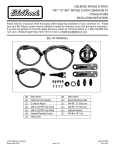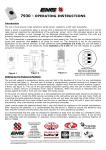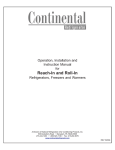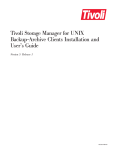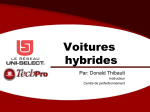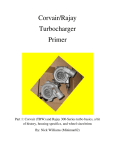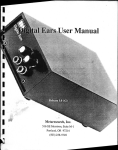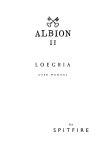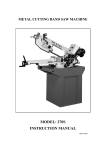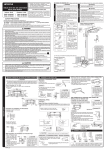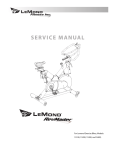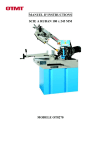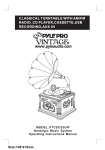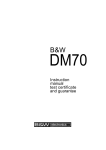Download 12VDC Strobe Kit! - Great Plains Aircraft!
Transcript
B E E T L E F L Y E R 2 0 1 1 Great Plains Aircraft Supply Co., Inc. • Bennington, NE 2011 New Products! Type 1 VW “Super Rear Seal”. A Good Friend Returns! 12VDC Strobe Kit! After a hiatus of several years due to a key component not being available, we are glad to announce that our 12VDC strobe light kit is available once again. The kit is priced at $34.95. The kit includes the pc board, strobe tube, components and assembly instructions. Spare parts are also available. Over the last 30 years, we have sold over 1000 of these popular strobe light kits! Happy Holidays! We hope that you had a great year and we wish you a Merry Christmas and Happy New Year. Great Plains Aircraft has introduced a new Type 1 VW rear seal (flywheel seal). This ‘PLS’ is a ‘PTFE Lined Seal’ – and ‘PTFE’ is short for ‘Polytetrafluoroethylene’. This seal’s face lip is bonded with PTFE, which has a very low coefficient of friction when compared to other seal materials. The PLS Seal fits all 109 or 130 tooth Type 1, stock VW flywheels and engine cases. The seal is 100% re-usable if removed with care. We have noted that the VW flywheel will groove over time with a standard Type 1 VW black or red silicone rear seal. This can cause the seal area around the flywheel to weep. The PTFE face is mounted on a flexible lip that enables the seal lip to maintain contact with the flywheel throughout the rpm range. The oil film at the seal/flywheel interface runs cooler with the PLS seal. This avoids the oxidation and chemical degradation problems with the oil film, which can often form abrasive carbon particles that will groove the flywheel/seal area. The PLS seal will run with 50 to 85% less friction when compared to a stock Type 1 VW seal. This reduces parasitic power losses and releases a little extra HP. The PLS seal technology has been endurance tested on a 80mm shaft, cycling between 7,000 and 12,000 rpm for 1000 hours during the development phase, using unhardened mild steel shafts. The seal never grooved the shaft (or flywheel) during any of the tests and did not weep. The Super Rear Seal sells for $24.95 plus postage. And the seal is NOT made in China! GREAT PLAINS AIRCRAFT BEETLE FLYER 2011 Rotten Weather! It seemed like Sun & Fun and Oshkosh couldn’t catch a break in the weather department in 2011! F1 Winds & Tornado hits Lakeland! Above: the remains of AirParts (of KC) The week started with only a very few aircraft being able to fly into the Air Show. And then, the storm blew in! Over 1,000+ show attendees and exhibitors were weathering the storm out with us in Building A. At the start of the storm, the roof vents blew out and water was flowing in! Then the lights went out. And that’s where we stayed until the storm passed and the security let us out of the building. Luckily only a few were inured! Close Call at Sun & Fun! We called (the picture to the right) a close one! We were very lucky that the 100’ tall tree to east of our camper dropped it’s top the opposite way of our trailer! Unfortunately two of the people we were camping with received vehicle damage. Bu others by us were not so lucky and had tree ornaments within their trailer! UGH! No Splosh Kosh in 2011! Luckily 2011 Oshkosh did not experience the unprecedented rain before the show that caused many campers and aircraft to be displaced to other locations in 2010. EAA made many upgrades for drainage and even the muddy campground (shown to the left) was nothing like the prior year! Great attendance both years! 2012 Sun & Fun and Oshkosh! We are already in the planning stages for both Air Shows! We are in Building A at Sun & Fun and Building D at Oshkosh. Watch for workshop schedules to be posted on our web site closer to the shows! SEE YOU THERE! 2 GREAT PLAINS AIRCRAFT BEETLE FLYER 2011 82mm Crankshafts We continue to offer our Type 1 1045 forged/welded 82mm crankshaft, as well as our E4340 Forged Billet Crankshaft. Both crankshafts use our exclusive Force One Prop Hub and Main Bearing assembly that supports the prop hub in a bearing assembly. The failure rate of both of these Type 1 Top Bug crankshafts (on normally aspirated engines) that utilizes the flat woodruff keys and ½” x 20 retention thread continues to be “0”. This is regardless of whether it is a customer assembled engine or an engine we have assembled. The price of both of these crankshafts is identical at $975.00, plus the hub and main bearing kit. Listed below are the actual bearing area and prop hub retention areas of a generic competitors shrink fit hub and crankshaft vs. our Force One hub and Main Bearing (shown below) and Top Bug crankshaft. Generic Shrink Fit Hub GPASC Force One Hub Retention Area: 3.763 sq in 8.949 sq in Bearing Area: 2.893 sq in 9.577 sq in There are BIG differences between crankshafts, prop hubs and main bearings used in Type 1 VW conversions! • GPASC’s bearing has over three times the surface area as a standard #4 VW main bearing. • GPASC’s Force One Prop hub is supported by the bearing. The shrink fit hub is forward of the #4 main bearing and is not supported by a bearing. • GPASC’s Force One Prop hub has 2-1/2 times the retention area of a shrink fit prop hub. • The taper on the GPASC Force One Hub and Crankshaft do not need a keyway. It is there only to index the hub for timing purposes. Not so with a shrink fit hub. • A 2180cc engine transmits about 125 ft. lbs. of torque to the hub/propeller. A 1915cc using a shrink fit hub transmits about 85 ft. lbs. of torque. When using a shrink fit hub on a 2180cc engine, the hub is transmitting a 48% increase of torque to the prop hub in the same small 3.783 sq. in. retention area. Additionally, our Type 1 VW Top Bug 82mm billet crankshaft is made from an American forged Timkin billet of steel and is machined in the USA with American labor. 3 GREAT PLAINS AIRCRAFT BEETLE FLYER 2011 New Flywheel Drive Accessory Packages! Firewall Forward Package now available! We are very pleased to announce that we now have a complete firewall forward package available for our flywheel drive engines. The motor mount and exhaust were designed to fit Bruce Kings new BK1.3 all aluminum single place VW powered homebuilt aircraft. The BK1.1 is pictured to the right. The firewall forward kit will fit any of our VW based engines from 1600cc up through 2300cc. Download our catalog for price information for the Flywheel Drive engine kits and accessories. We have a complete bed frame style engine mount, laser cut flywheel side mount bracket, 35 amp 3 phase alternator and mounting kit, prop hub, flywheel, starter with mounting kit, exhaust system complete with shrouds for carburetor and cabin heat, intake manifold and of course the carburetor. 4 GREAT PLAINS AIRCRAFT BEETLE FLYER 2011 Assembly of Crankshaft Gear Kit This process continues to cause installation problems for many. Getting the gears “stuck” halfway on the crankshaft is of course no fun! They have to be pulled back off. Prior to heating the gears do the following: 1. Make sure the large woodruff key easily slides through both the cam timing gear and the brass drive gear. If not, either make the slots in the gear a little wider - evenly on both sides or remove some material from both sides of the woodruff key. 2. The top of the key may hit the top of the gear. With the key installed, place the gear(s) over the nose of the crankshaft and visually “look” to see if they will hit the top of the gear. If so, remove .005” to .010” with a file to make sure the key clears. 3. Many times you have to file a small radius on the edge of the large woodruff so it does not “grab” gears when they are installed. 4. If you are using a Racer Gear Spacer, you will have to wait until the Cam Timing Gear and crankshaft cool off, before you install the Racer Spacer and the brass drive gear. The Cam Timing Gear, has enough stored energy, i.e. heat in it that it transfers to the crankshaft and can warm (expand) the crankshaft up enough that the racer spacer will not go over the crankshaft or woodruff key until the crank is cool. Shrink Fit Hub Assembly The shrink hub has the same issues as the crankshaft gear kit. The small woodruff key has to easily slide in and out of the woodruff key slot in the prop hub. Our shrink fit hubs actually have a somewhat rounded slot. This is to prevent splitting the hub in the keyway due to “square corners”. So, the small woodruff key has to have the edges “rounded”. Check your crankshaft next. If you notice any burrs on the crankshaft nose, polish them out with 400 emery cloth - so the hub does not grab any burr or nick. Burrs are often found on stock VW rebuilt German crankshaft, not new aftermarket crankshafts. Once you are ready to heat the hub up, install the #4 main bearing, the oil slinger with the cup facing forward and then lightly tap the small woodruff key in place. We place the shrink fit hub on a hot plate with the shaft down on the plate. It will get heated up to about 450º F. After about 15 minutes the hub is warm enough to slip over the shaft. It needs to bottom out against the oil slinger and hold it in place. We put a heavy weight on the nose of the hub to keep a little compression force on the assembly so the hub stays tight against the slinger. If the hub goes on half way, just quit. You do not want to have to use a press, hammer and block etc.… to force the hub on at this time. You must remove the hub, see what went wrong and start over. 9 times out of 10, it’s the woodruff key or a burr on the nose of the crankshaft. 5 GREAT PLAINS AIRCRAFT BEETLE FLYER 2011 Incorrect Rocker Arms There continues to be wide spread use of rocker arms manufactured by one company and sold by many (shown in the picture to the right… the arm on the right), that should not be used in aircraft nor cars. Check your rocker arms to verify that the oil hole that is drilled through the rocker arm has been welded shut (as shown on the left). The purpose of oil in the rocker arm is to: 1: Lubricate the rocker arm bearing and shaft. 2. To lubricate the valve head, stem and guide. 3. To absorb heat and transport it to the oil cooler to be rejected. 4. And for a little humor, to cause the valve cover to leak! Welded Shut Not Welded Shut When using an “open” non-welded rocker arm (on the right), the oil spills out over the top of the rocker arm and is not forced down the threads and onto the valve head, stem and guide. In earlier VW engines this style of rocker arm had caused pre-mature valve and valve guide failure, so VW started welding the holes shut. Yes, your engine will run with this style of rocker arm, but you really should replace them if you find them on your engine. Oil Pickup Tube One item to check prior to engine assembly is the relation of the oil pickup tube to the bottom of the oil screen. Some of the tubes that come from the factory with a square end on them and are just off the bottom of the oil screen by 1/16” of an inch or so. If you were to make the mistake of using a hammer to lightly tap the oil filter screen into place on the 6 studs, you could collapse the screen against the pick up tube. HAPI No Longer… To date, we have replaced 112 flywheels and alternators in HAPI Accessory Cases. Since 1992, we have been changing out the cast aluminum HAPI flywheels that cracked around the dowel pin holes. Our former alternator supplier is no longer in business and we can no longer supply that style of alternator that fits inside the HAPI Accessory Case. Our new 35 amp alternator magnet ring is .375” thicker (or longer) than the old 22 amp magnet ring. Sorry to those who have not made the required change. 6 GREAT PLAINS AIRCRAFT BEETLE FLYER 2011 Builders Tips: Secondary Ignition Seal: Some of our secondary ignition systems are getting quite a bit of time on them and a few shafts are getting too much side play. If you have a low height secondary that has bronze bushing installed in bore for the shaft, they of course can be pressed out and replaced. If the bore is all aluminum as found on later models, the bore can be drilled with a pilot drill and reamer, and bronze bushings installed on both ends. One builder wanted to add a seal as he was getting oil in the upper part of the secondary housing. He found that Chicago Rawhide’s seal number 4912 will fit inside the housing as long as a small counter bore is made to set the seal in. Another builder had acquired the tool set to perform this minor machine operation. After he used it, he was gracious and sold it to us. As a result, all of our low height secondary ignition systems housings now have an oil seal installed. Thanks to Gaston and Scott for a great idea and the tools to get the job done. Oil Pressure: Another customer has a competitor’s engine (with some of our parts on it also). He was having trouble maintaining cruise oil pressure. He found the seat area for the oil pressure control plunger was not flat. So he made a tool that goes down in and cleans up the seating surface for the plunger. This is a potential problem that has been around for quite a while. After he used the tool to clean up his case, he was kind enough to send it to us on permanent loaner status. So if anyone else has this problem, the tool can be sent out to any engine builder that needs it. After this the cruise oil pressure problem was cured, he did not like the way his engine on start up… spiked at 100 psi and then dropped to 40 psi after it was at operating temperature. He machined .025” off the top of the front plunger (hour glass shaped one) and .025” off the rear plunger, from the top of it, down .300”. This cured his problem with spiking oil pressure. Might point out that heavier weight oil than we specify for our engines was being used. But thanks to Merle for both the loaner tool and suggestion on controlling spiked oil pressure. 7 GREAT PLAINS AIRCRAFT BEETLE FLYER 2011 NEW BOOKS Now Available! We have added nine new educational books to our book shelf! Each of the new books are priced at $19.95 (plus postage). Check our web site for a full description of each book. And when you check out our Beetle Flyer Sale Items…. If you purchase 3 educational books we will ship them free in the USA! They don’t have to be the new books – just three books! Our Assembly Manual and DVD set is considered one book. (Our VW Catalog is not considered a book.) And if you live outside of the USA… We will give you a credit for $5! 8 GREAT PLAINS AIRCRAFT BEETLE FLYER 2011 Frequently Asked Questions… Answered here! Does the Diehl Accessory Case have the same dimensions as the AeroVee accessory case? Yes, the two case share common dimensions for attachment to an engine mount. We have many Diehl Accessory Case equipped engines installed and flying in the various Sonex type aircraft. it. Having the valve guide finned areas open so air can flow through from top to bottom can make up to an 80ºF difference (less if opened up) in cylinder head temperature. When I compare an 80hp Rotax to a 80hp direct drive VW, the VW is a lot less money. But you tell me it won’t fly my Zenith 701? Good old classic question… The difference is in the torque the propeller sees. The Rotax has that accessory called a “gear box” on the front of the engine. One of the ratios is 2.47:1. So now we compare. The Rotax 912 engine will produce 79.5 ft. lbs. of torque. Take the torque time 2.47:1 and this is what the prop sees 196 ft. lbs. of torque. In addition, with a slow turning 72” diameter prop, it will produce 350ish pounds of static thrust. Will the prop hub lay in the same forward position as an AeroVee with a shrink fit hub? For all general fitting purposes - yes. They fall within 1/16” of an inch of each other. I see you now offer a 35 amp, 3 phase alternator. How is that different from the old 22 amp alternator you had previously? The 22 amp alternator manufacturer couldn’t make it during the current hard economic times. In our search for a new alternator to replace it, we took into consideration that universally: 1. Everyone wanted more output and 2. Almost all wanted to eliminate any alternator radio noise. A direct drive 80 HP VW does not have a gear box. It will make 125-ish ft. lbs. of torque on average. With a 62” prop, which is about the biggest it can turn - due to tip speed, it will make 225 pounds of thrust. Our new 35 amp, 3 phase alternator does both. All the rated amps are “all in” by 1500 rpm. The 3 phase eliminates all possible radio noise that could be produced by the alternator. So this is why on Zenith 701’s, we use the ReDrive on the VW engine. The 2180cc engine with a 1.6:1 re-drive will produce 140 ft. lbs. of torque at 3800 rpm. 140 ft. lbs. X the 1.6:1 drive ratio, equal 224 ft. lbs. of torque at the prop. We still have supplies for the older 20 and 22 amp alternators. We can also supply replacement stator and regulator. The magnet rings are no longer available. What is the major wear item in VW engines? Without a doubt, the cylinder heads and valve train. When comparing cylinder heads, look for a casting number that ends in 355H or 355C (when evaluating large valve heads). Both of these heads have superior airflow in the valve guide area. Many aftermarket cylinder heads have the valve guide finned area of the cylinder head nearly 100% plugged or very close to 9 GREAT PLAINS AIRCRAFT BEETLE FLYER 2011 Frequently Asked Questions… More Answers here! I have heard you state in your workshops, that your engines do not have a TBO after X amount of hour. I find that hard to believe? You’re most likely confusing required maintenance vs. a mandatory overhaul. Aircraft engines - Continentals and Lycomings (when not used for commerce), do not have a mandatory overhaul time after ‘X’ hours either. Stop and think about other engines you use. Your car, truck, lawn mower, weed whip, etc… None of these engines have a mandatory overhaul time frame, but all have suggested maintenance intervals. A VW conversion is not any different. We maintain a list of suggested periodic maintenance and annual maintenance as found in our current service manual on page 47. At annual one should at least record the following - in addition to annual engine maintenance: Cold: 1. Check the torque on the cylinder heads - cold At Operating Temps: 2. Record oil pressure of engine 3. Record oil temperature of engine 4. Record Cylinder head temperature of engine 5. Perform a differential cylinder leak down test 2 – 5 should be done with the engine thoroughly warmed up, preferable in a flight just before annual. They are many other items to check at annual, but these are the primary ones to check and record in you log book so that you can see an annual trend. When a cylinder is low or oil pressure drop by more than 15 – 20 percent or so from new pressure recording, using the same weight oil at the same temperature that would indicate it would be time to start to do a further inspection. Why is a direct drive VW engine limited to about 3400 rpm spinning a 62”diameter? The answers lie in the equations listed below – 3400 rpm x 62” diameter prop x .00436 = 919 feet per second at sea level Tip speed RPM X Diameter Inches X .00436 = tip speed (Ft/Sec) The normal maximum for a prop is 900 Ft/Sec 2700 X 68 X .00436 = 800 Ft/Sec A smaller diameter prop can of course turn a higher rpm. On the other extreme look at a 6” prop used on a RC model. 12,000 rpm x 6” prop x .00436 = 313.92 feet per second One of the Sonerai 1 racers runs a 48” diameter prop and routinely runs about 4000 rpm. So… 4000 rpm x 48” prop x .00436 = 837 feet per second. 10 Great Plains Aircraft Supply Co., Inc. Beetle Flyer 2011 th th 30 Anniversary! 2012 marks the 30 Anniversary year for Great Plains Aircraft Supply Company. Started in 1982 in Omaha, Nebraska. We were at our original location for 1 short year. In 1983 we moved to Palatine, Illinois and were there from 1983 to 1989. In 1989 we moved to St. Charles, IL. Then in 1993 we moved back to Omaha, NE and have been in the area since. Our new location is 1 block out of the Omaha city limits! When we originally started business, the most popular VW powered homebuilt’s were the KR, Sonerai series, Q2, Dragonfly, VP1 and VP2, Corby Starlet, Preceptor Aircraft - with a spattering of others. The major VW aircraft engine suppliers were HAPI, Barker, RevMaster and Monnett Experimental, While all of the above airframes are still around, that crop has been replaced with Dave Thatcher’s CX-4, the Monnett’s 4 VW powered aircraft: Sonex, Waiex, Xenos and Onex, and Bruce King’s soon to be released BK1.3 as the most popular VW powered aircraft of today. Aluminum has certainly replaced wood, foam and fiberglass as the building material of choice. When we first started in business, a Slick 4016 magneto sold for $150.00 and now the 4316 is $1099.00. VW engine cases sold for $150.00! Now a stock case is $700.00. A Mahle piston and cylinder set was $85.00 and now $425.00. And in 1986 we were selling a complete dual ignition direct drive 2180cc engine kit for $3495.00! I was just 29 when the business was started. I have had the great fortune of being able to attend every “Oshkosh” since 1972 and every Sun and Fun since 1984. Plus, Linda and I plan on continuing those traditions! We have seen the growth of EAA and Sport Aviation, the expansion of companies that support this great hobby and the thousands upon thousands of every day folks that have been empowered to “build and fly” their own aircraft. Hats certainly have to go off to the Poberezny’s – Dad, Mom and Tom and the early board of directors for the wisdom to grow our hobby. I think I can attest that some wisdom does come with age. But can also state that - “what goes around comes around.” Many of the same engine building mistakes made in the 1970’s continue to be made again today, especially with cast crankshafts, shrink fit hubs, carburetion and cooling. For an engine to be popular in the sport aviation market place, it has to have airframe designers who choose an engine “of choice”. The VW engine currently flies on close to 100 different airframes worldwide. It has, and continues to be a reliable, workhorse engine. From both Linda and I, we would like to thank all of our customers, many of who have turned in to life’s greatest friends, for your past and continued support. We will continue to do our best to have reliable, affordable and available VW based engines and parts, well into the future…. Great Plains Aircraft Supply Co., Inc. Beetle Flyer 2011 Turbo Charging the VW…Thoughts… Adding a turbo to the VW aircraft engine is nothing new. This was popularized by RevMaster Aviation in the late 1970’s and early 1980’s. Many of our friends that had KR’s at the time flew with a turbo for a few years. The sole purpose of a turbo on a VW engine converted for aircraft use (our opinion only) is to normalize the engine when it is at altitude. This simply means that at sea level you see 29.9 inches of manifold pressure on take off. Most engines at sea level pull 28 something. You might be able to boost about 1 to 2 inches because of pressure drop and restrictions in the intake and air the inlet temperature as there is no intercooler used to cool the air the engine uses for combustion. When we get to 10,000 feet or so, on a non- turbo charged engine, one see’s about 19 to 20 inches of manifold pressure with the engine just about at wide open throttle. The VW will be spinning about 3400 to 3500 rpm at the altitude (if the prop for the aircraft is sized correctly). So if we had a turbo and added back the boost to get even up to 23 inches of MP, which is 75% power, the rpm’s would increase to about 3800 rpm. Yes, you would go a little faster, but… there is always a ‘but’ isn’t there? But, without the use of a constant speed prop or twospeed prop, one really can’t take advantage of the turbo. You want to bring the rpm’s back down to about 3200 and the Manifold Pressure up to 23 inches. Without more pitch in the prop, this is impossible to do. There is not an affordable production 2 position or constant speed prop that is available (to our knowledge) to add to the VW engine. Back in the 1980’s Maloof made an adjustable pitch prop for VW engines. But it did not have a long history of service on the VW engine for various reasons. The main problem, an affordable, reliable, adjustable 2 position or constant speed prop, 30 some years later is still not available to use on the VW aircraft conversions with a turbo. Most if not all of the early attempts at turbo charging VW engines was done without a blow off valve (waste gate) to limit the boost. Boost was controlled solely by the position of the throttle. As you can imagine, at sea level, it was very difficult for pilots not to add full throttle on take off! Back in the day, turbo charger users added a lot more pitch to the prop. This of course would decrease climb performance and take off rpm. Once at altitude the extra pitch would then help the aircraft go faster. But as most of us spend our flying time below 5,000 feet, well… you get the picture!












